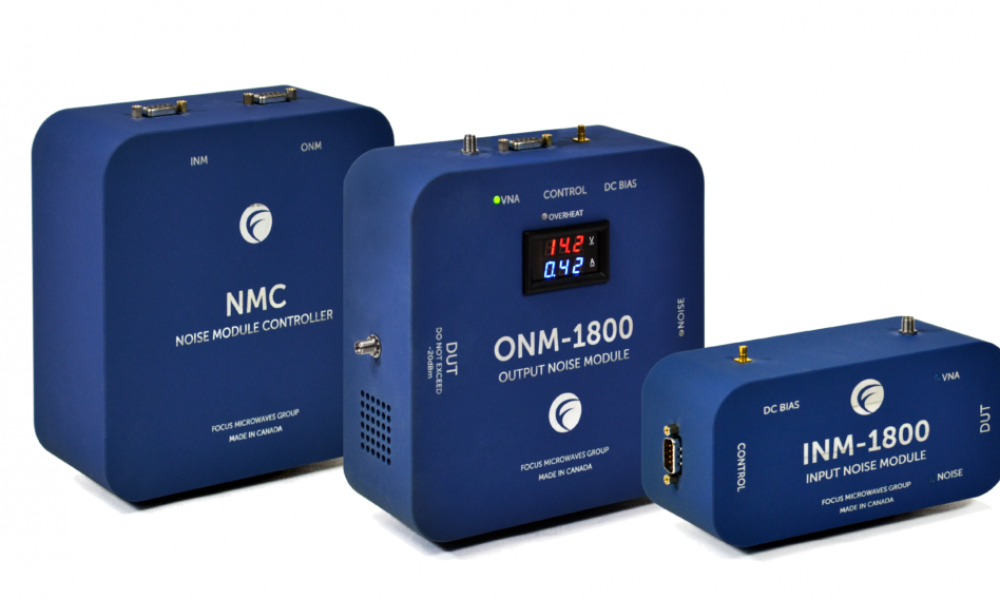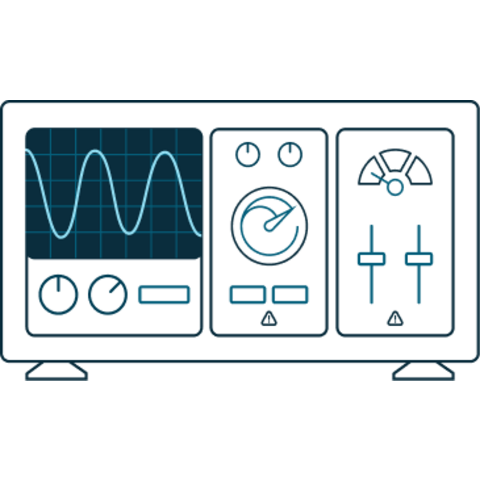Focus Microwaves - Noise Modules
of the cold-source noise figure measurement technique. This specific technique requires a noise source to determine the kBG (gain-bandwidth constant) of the system and a passive mechanical tuner is used to characterize the noise receiver across both the impedance and frequency space. This step is imperative to obtain fully vector-source-corrected measurements.
A RF down conversion stage might be required if the frequency of noise measured exceeds the receiver’s bandwidth. Focus offers noise modules which support down conversion for optimal speed and performance.
Hardware
Noise Measurement System
| Model | Frequency | Insertion Loss | VSWR | Min. Gain | Max. VSWR | Connector |
| NMS-2600 | up to 26.5 GHz | 0.80 dB | 1.61 | 29 for 0.8-26.5GHz | 1.8:1 | 3.5mm |
| NMS-4000 | up to 40 GHz | 0.91 dB | 1.81 | 30 for ≤26.5GHz, 29 for 26-40GHz | 2.1:1 | 2.9mm |
| NMS-5000 | up to 50 GHz | 0.99 dB | 1.8:1 |
27 for ≤26.5GHz, 27 for 26-40GHz, 28 for 40-50GHz |
2:1 | 2.4mm |
| NMS-6700 | up to 67 GHz | 1.12 dB | 1.91 |
29 for ≤26.5GHz, 28.5 for 26-40GHz, 28 for 40-50GHz, 21 for 50-65GHz |
3:1 | 1.85mm |
| NMS-6700-DC* | up to 67 GHz | 1.12 dB | 1.9:1 |
29 for ≤26.5GHz, 28.5 for 26-40GHz, 28 for 40-50GHz, 37 for 50-65GHz |
3:1 | 1.85 mm |
| NMS-75500-DC* | 50 to 75 GHz | 0.4dB | 1.2:1** | 40 for 50-75GHz | 1.6:1** | WR-15 |
| NMS-90600-DC* | 60 to 90 GHz | 0.9dB | 1.3:1** | 35 for 60-90GHz | 1.8:1** | WR-12 |
| NMS-110750-DC* | 75 to 110 GHz | 1.1dB | 1.3:1** | 36 for 75-110GHz | 1.9:1** | WR-10 |
| NMS-1701100-DC* | 110 to 170 GHz | 1.3dB | 1.4:1** | 36 for 110-170GHz | 2:1** | WR-6.5 |
* with Downconverter
** +/-10%
Graphs
Noise Parameters
Noise Circles & Stability Regions
Noise Parameters: Minimum Noise Figure / Rn / Gamma Opt / Phase of Gamma Opt
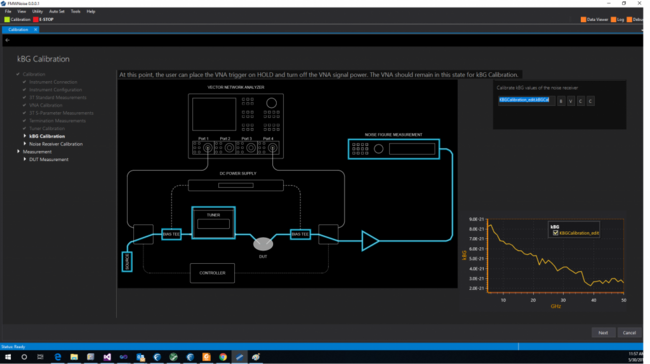
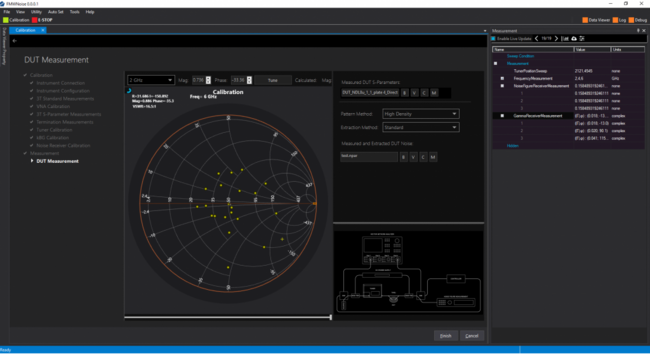
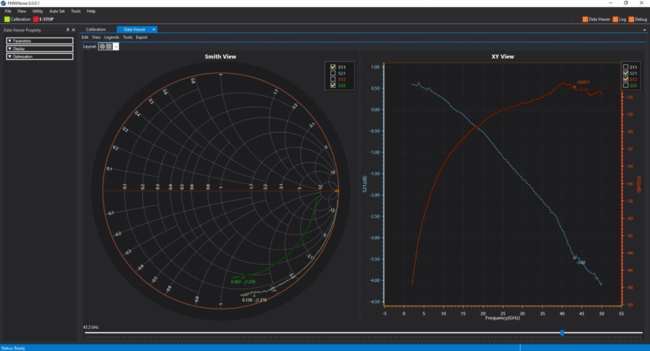
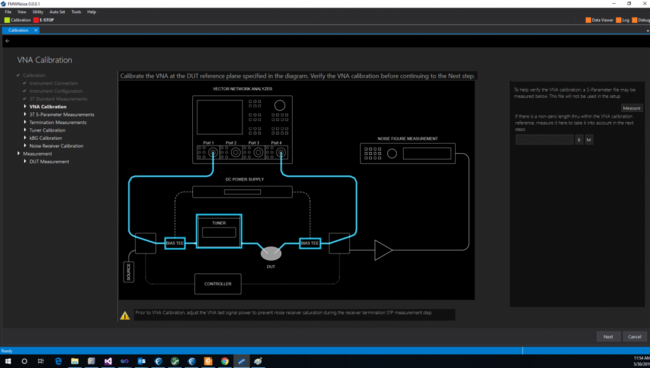
Setup
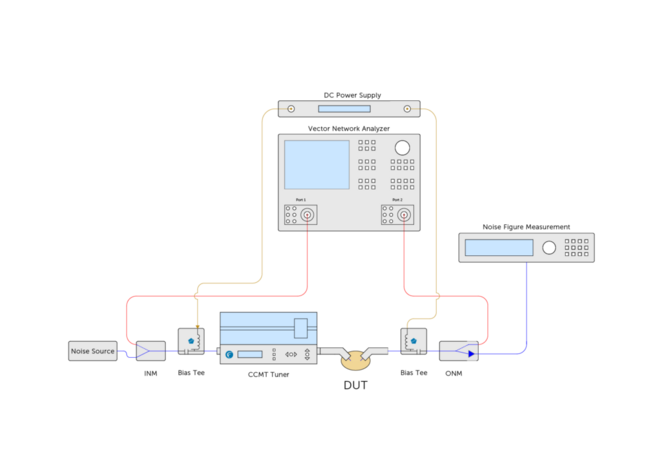
More Product Information
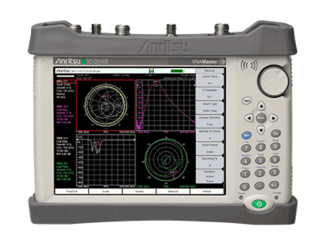
VNA Master (500 kHz to 4 GHz)
- 2-port, 1-path Vector Network Analyzer (VNA) Intuitive Graphical User Interface (GUI) with resistive TFT Touch Screen
- Exceptional RF immunity
- 100 dB Transmission Dynamic Range Vector
- Voltmeter option, ideal for cable phase matching
+Spectrum Analyzer (9 kHz to 4 GHz)
- Dynamic Range: > 95 dB in 10 Hz RBW
- DANL: –162 dBm (1 Hz)
- Phase Noise: –100 dBc/Hz max @ 10 kHz offset at 1 GHz
- Frequency Accuracy: < ±50 ppb with GPS On
- Detectors: Peak, Negative, Sample, Quasi-peak, and true RMS
- PIM Hunting
- Standard three-year warranty (battery one-year warranty)
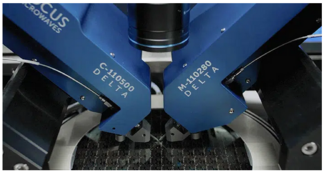
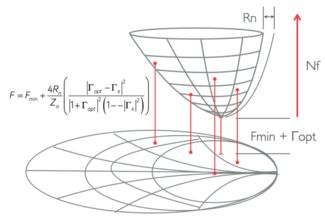
Noise measurements allow the determination of the four Noise Parameters of a device (transistor). There are four Noise Parameters which fully describe the noise behaviour of an active or passive device at a given frequency.
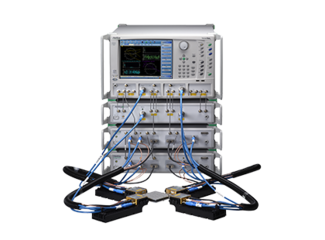
The VectorStar ME7838x4 broadband system VNA offers the widest available 4-port single sweep measurements from 70 kHz to 110, 125, 145, and 150 GHz with mmWave bands up to 1.1 THz
- The ME7838E4X 4-port system sweeps from 70 kHz to 110 GHz (Guaranteed specifications)
- The ME7838A4X 4-port system sweeps from 70 kHz to 125 GHz (Guaranteed specifications)
- The ME7838D4 4-port system sweeps from 70 kHz to 145/150 GHz
- The ME7838G4 4-port system sweeps from 70 kHz to 220 GHz
- All systems may be configured to include banded millimeter-wave modules up to 1.1 THz
- Industry-best calibration and measurement stability: 0.1 dB vs 0.6 dB over 24 hrs
- All systems also supports the 3744x-Rx receiver for noise figure measurements to 125 GHz
- Compact, lightweight mmWave modules offer low cost installation with industry-best performance
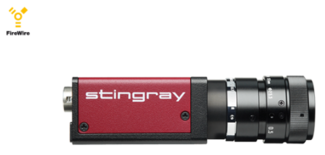
-
High SNR mode (up to 24 dB better signal-to-noise ratio)
-
Low-noise binning mode
-
Shading correction
-
Defect pixel correction
-
Area of interest (AOI), separate AOI for auto features
-
Binning
-
Decimation
-
Auto gain (manual gain control: 0 to 24.4 dB)
-
Auto exposure (25 µs to 67 s)
-
Auto white balance
-
Look-up table (LUT)
-
Hue, saturation
-
Color correction
-
Local color anti-aliasing
-
Reverse X/Y
-
Deferred image transport
-
Trigger programmable, level, single, bulk, programmable delay
-
Sequence mode (changes the camera settings on the fly)
-
SIS (secure image signature, time stamp for trigger, frame count etc.)
-
Storable user sets
-
Camera and IEEE 1394b cable (other configurations on request)
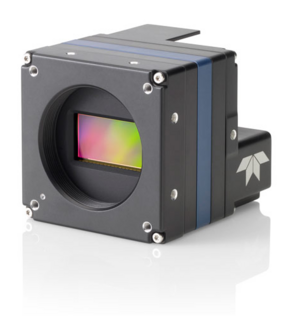
- Reduced dark noise levels and improved dark offset
- Improved sensitivity, including NIR response
- In-camera image pre-processing (lens shading correction, pixel correction)
- Large full well when using in-sensor binning >142Ke
- Thousands of frames per second in Partial Scan Mode (ROI)
- Multi-ROI support (up to 32 ROI) and Cycling Mode
- Advanced Sequencer functions of different features
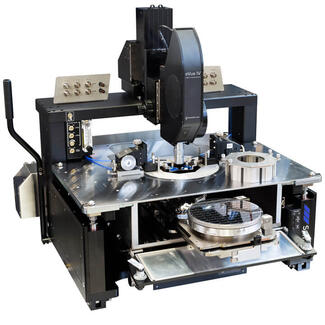
-
Re-configurable for DC, RF, mmW, FA, WLR and more
-
Thermal range: -60˚C to 300˚C available
-
Upgrade path to meet your future needs
-
Stable and repeatable measurements over a wide thermal range
-
Moisture-free, light-tight and EMI-shielded test environment with MicroChamber® technology
-
Advanced EMI-shielding with PureLine with AttoGuard technologies
-
Best solution for low-noise and 1/f measurements
-
Minimize AC and spectral noise
-
Minimizes settling times for efficient measurements, without compromising accuracy over full thermal range
-
Locking roll-out stage
-
Innovative microscope remote control
-
Intuitive ergonomic stage controls
-
Quick, safe, and comfortable wafer access
-
Easy on-wafer navigation
-
Fast setup and test data gathering
-
Dedicated Velox version for manual probe stations
-
AugmentedAlign tool with on screen markers for improved RF measurement accuracy
-
High SNR mode (up to 24 dB better signal-to-noise ratio)
-
Low-noise binning mode
-
Smear reduction
-
Shading correction
-
Area of interest (AOI), separate AOI for auto features
-
Binning
-
Decimation
-
Auto gain (manual gain control: 0 to 24 dB)
-
Auto exposure (27 µs to 67 s)
-
Auto white balance
-
Look-up table (LUT)
-
Hue, saturation, color correction
-
Reverse X
-
Deferred image transport
-
Trigger programmable, level, single, bulk, programmable delay
-
Sequence mode (changes the camera settings on the fly)
-
SIS (secure image signature, time stamp for trigger, frame count)
-
Storable user sets
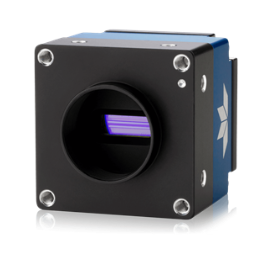
Linea SWIR features a cutting-edge InGaAs sensor in a compact package that is suitable for a wide variety of applications. With exceptional responsivity and low noise, this camera allows customers to see their products like never before. Linea SWIR is available as a 1k resolution camera with highly responsive 12.5 µm pixels, or a 512 resolution camera with larger 25 µm pixels.

Focus Microwaves
Focus Microwaves is a pioneering engineering company, built around the innovations of its founder Dr. Christos Tsironis who developed his first manual tuner in 1973 and is the inventor of most existing electro-mechanical tuner families. The success of Focus is based on the engineering and manufacturing skills of its highly motivated and experienced team of engineers and technicians, who have been trained and encouraged to develop new technologies. In addition, listening to our customers needs and insights helps us discover and develop new and measurement methods on an ongoing basis, relentlessly pushing the limits of what is possible.
From humble beginnings in 1988, Focus has become the main supplier of advanced Load Pull and Noise Tuner Systems. Our mission is to provide effective, reliable and innovative solutions for non-50 Ohm testing (Noise and Load Pull) of RF microwave transistors, thus enabling our customers to compete in the marketplace with better designs and to advance the understanding and knowledge of the field.
Contact Details
Focus Microwaves Inc. Main Head Office
4555 Chem. du Bois-Franc, Saint-Laurent, QC H4S 1A8, Canada
Phone: +1-514-684-4554
Test & Measurement
